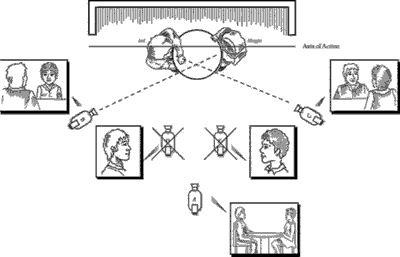 At the beginning of the titling sequence, it begins with bright, small circles quickly fading in onto a black background and then disappearing as the fist name comes on the screen, in small white letters. This all happens relatively quickly, suggesting to the audience that the film is going to be fast paced. These fast-paced transitions are accompanied by discordant music which ranges from high to low pitch as the titles appear on the screen. Scratching sounds can be heard within the music, making it uncomfortable for the audience to listen to and already has them on edge.
At the beginning of the titling sequence, it begins with bright, small circles quickly fading in onto a black background and then disappearing as the fist name comes on the screen, in small white letters. This all happens relatively quickly, suggesting to the audience that the film is going to be fast paced. These fast-paced transitions are accompanied by discordant music which ranges from high to low pitch as the titles appear on the screen. Scratching sounds can be heard within the music, making it uncomfortable for the audience to listen to and already has them on edge.
An image of a shadow of two hands flashes up very quickly whilst another title is added on the screen. This image is in black and white, still with the black background as before, making the audience potentially question what they have just seen, making them on edge and anticipating the next part of the film.

As the title 'Red Lights' appears on the right of the screen, in the center in capital letters and white writing, large red circles, which look to be lights, quickly flash up around the title, and then disappear randomly. To the left of the title, large white circles flash up and move around slightly and fade away quickly, which could make the audience feel rushed or shaken.
 An extreme close up image of an eye appears in large to the left of the screen in black and white, so the audience can see the veins and the eye in detail. This could make the audience feel uncomfortable again, yet it makes them wanting to know why this is relevant for later in the film.
An extreme close up image of an eye appears in large to the left of the screen in black and white, so the audience can see the veins and the eye in detail. This could make the audience feel uncomfortable again, yet it makes them wanting to know why this is relevant for later in the film. 
More images flash up on the screen randomly, some having been edited to that they jerk around the screen and some staying still, yet all in black and white. These images vary from an image of a Polaroid with a woman on it, to an image of a woman with tape over her eye, and an x-ray of a skeleton. These are all in black and white, suggesting that the images are hiding something that could be seen when in colour, for example, blood on a woman's face. By engaging the audience, this keeps them in suspense, all the while the discordant music is playing in the background, continuing to make the audience feel uncomfortable.



































